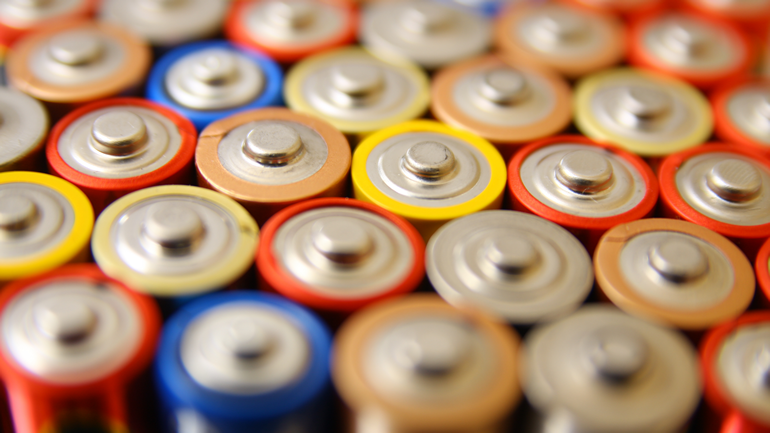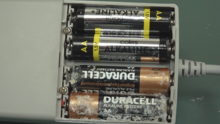@Bort: So that means both brands leak after expiration, however Duracell leak less? (more slowly)
I don't trust the article, it looks like they scraped information from different sites and slammed it into one article to generate ad revenue. For instance they're mentioning how Duracell alkaline can only be recharged 400 times but Energizer can be recharged 1500 times. Plus they focus on flashlight usage as being a huge current draw, which is horribly out of date as most consumer lights are LED and draw very little current. (At BLF we tend to...well, you know we're "different.")
I found more information once identifying what we're interested in is called "gassing rate." From Wikipedia:
Leaks
Potassium compound leakage inside an alkaline battery
Alkaline batteries are prone to leaking potassium hydroxide, a caustic agent that can cause respiratory, eye and skin irritation.[note 1] The risk of this can be reduced by not attempting to recharge disposable alkaline cells, by not mixing different battery types in the same device, by replacing all of the batteries at the same time, by storing batteries in a dry place and at room temperature, and by removing batteries for storage of devices.
All batteries gradually self-discharge (whether installed in a device or not) and dead batteries will eventually leak. Extremely high temperatures can also cause batteries to rupture and leak (such as in a car during summer) as well as decrease the shelf life of the battery.
The reason for leaks is that as batteries discharge — either through usage or gradual self-discharge — the chemistry of the cells changes and some hydrogen gas is generated. This out-gassing increases pressure in the battery. Eventually, the excess pressure either ruptures the insulating seals at the end of the battery, or the outer metal canister, or both. In addition, as the battery ages, its steel outer canister may gradually corrode or rust, which can further contribute to containment failure.
Once a leak has formed due to corrosion of the outer steel shell, potassium hydroxide absorbs carbon dioxide from the air to form a feathery crystalline structure of potassium carbonate that grows and spreads out from the battery over time, following along metal electrodes to circuit boards where it commences oxidation of copper tracks and other components, leading to permanent circuitry damage.
The leaking crystalline growths can also emerge from seams around battery covers to form a furry coating outside the device, that corrodes any objects in contact with the leaking device.
More detail on why this recently became a problem from Science Direct:
The removal of mercury from alkaline cells in the 1980s and its ultimate elimination in the early 1990s had a large potential impact on gassing (hydrogen generation by corrosion) risks, load capability, and shock sensitivity. The battery industry identified two approaches to reduce gassing without compromising performance: zinc alloys and additives in the electrolyte. Even with low gassing zinc powders, impure cell components could induce zinc gassing after battery assembly. It was a requirement that the purity of all cell components be improved in alkaline mercury-free cells.
The most used alloying element is bismuth, especially in the context of lead-free zinc alloys, and the most frequently paired elements are bismuth and indium, bismuth and calcium, and bismuth and aluminum. The most common ternary alloys are bismuth–indium–aluminum and bismuth–indium–calcium. The typical concentration of these elements ranges from 0.001% to 0.1%, and is preferably around 0.01%. The gassing inhibition is ascribed to the increased hydrogen overvoltage by bismuth and indium, and a surface smoothing effect of calcium and aluminum.
Postpartial or after-discharge zinc gassing appeared with the elimination of mercury and it strongly depends on the depth of discharge, alloying elements, and iron concentration in the zinc anode. Aluminum and calcium were found to decrease the effects of anodic discharge on after-discharge gassing.
The addition of bismuth and indium to zinc reduces zinc gassing in general, whereas the addition of aluminum or calcium decreases the after-discharge gassing. Those elements also impact on the rate capability of zinc alloys, namely, by impacting on the anodic passivation of zinc in alkaline electrolytes.
Zinc alloy powder used in the anode is also characterized by particle size and shape distributions. Such distributions have been found to impact on anode density, resistivity, shock sensitivity, and gassing. Typical size distributions follow log–normal distribution, with mean diameter ranging from 100 to 200 μm, and distribution width (sigma) ranged from 1.4 to 1.7. Bimodal size distributions or finer size distributions display superior high rate performance.
It seems Fenix is quite possibly correct.
Thank you for your thoughts, this has been quite informative.
---
Somewhat on another topics, how to recharge alkaline batteries (not rechargeable alkaline manganese (RAM) batteries). Wikipedia also notes disposable alkaline batteries can be recharged and offers more insight.



